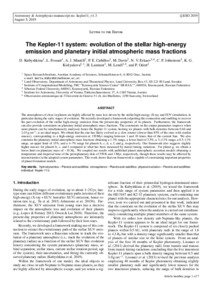The Kepler-11 system: evolution of the stellar high-energy emission and initial planetary initial atmospheric mass fractions
Скачать файл:
URI (для ссылок/цитирований):
https://www.aanda.org/articles/aa/abs/2019/12/aa36581-19/aa36581-19.htmlhttps://elib.sfu-kras.ru/handle/2311/142935
Автор:
Kubyshkina, D.
Fossati, L.
Mustill, A. J.
Cubillos, P. E.
Davies, M. B.
Erkaev, N. V.
Johnstone, C. P.
Kislyakova, K. G.
Lammer, H.
Lendl, M.
Odert, P.
Коллективный автор:
Политехнический институт
Кафедра прикладной механики
Дата:
2019-11Журнал:
ASTRONOMY & ASTROPHYSICSКвартиль журнала в Scopus:
Q1Квартиль журнала в Web of Science:
Q1Библиографическое описание:
Kubyshkina, D. The Kepler-11 system: evolution of the stellar high-energy emission and initial planetary initial atmospheric mass fractions [Текст] / D. Kubyshkina, L. Fossati, A. J. Mustill, P. E. Cubillos, M. B. Davies, N. V. Erkaev, C. P. Johnstone, K. G. Kislyakova, H. Lammer, M. Lendl, P. Odert // ASTRONOMY & ASTROPHYSICS. — 2019. — Т. 632 (A65).Аннотация:
The atmospheres of close-in planets are strongly influenced by mass loss driven by the high-energy (X-ray and extreme ultraviolet, EUV) irradiation of the host star, particularly during the early stages of evolution. We recently developed a framework to exploit this connection and enable us to recover the past evolution of the stellar high-energy emission from the present-day properties of its planets, if the latter retain some remnants of their primordial hydrogen-dominated atmospheres. Furthermore, the framework can also provide constraints on planetary initial atmospheric mass fractions. The constraints on the output parameters improve when more planets can be simultaneously analysed. This makes the Kepler-11 system, which hosts six planets with bulk densities between 0.66 and 2.45 g cm−3, an ideal target. Our results indicate that the star has likely evolved as a slow rotator (slower than 85% of the stars with similar masses), corresponding to a high-energy emission at 150 Myr of between 1 and 10 times that of the current Sun. We also constrain the initial atmospheric mass fractions for the planets, obtaining a lower limit of 4.1% for planet c, a range of 3.7–5.3% for planet d, a range of 11.1–14% for planet e, a range of 1–15.6% for planet f, and a range of 4.7–8.7% for planet g assuming a disc dispersal time of 1 Myr. For planet b, the range remains poorly constrained. Our framework also suggests slightly higher masses for planets b, c, and f than have been suggested based on transit timing variation measurements. We coupled our results with published planet atmosphere accretion models to obtain a temperature (at 0.25 AU, the location of planet f) and dispersal time of the protoplanetary disc of 550 K and 1 Myr, although these results may be affected by inconsistencies in the adopted system parameters. This work shows that our framework is capable of constraining important properties of planet formation models.
Коллекции:
Метаданные:
Показать полную информациюСвязанные материалы
Показаны похожие ресурсы по названию, автору или тематике.
-
Supermassive hot Jupiters provide more favourable conditions for the generation of radio emission via the cyclotron maser instability - a case study based on Tau Bootis b
Weber, C.; Erkaev, N. V.; Ivanov, V. A.; Odert, P.; Grießmeier J.-M.; Fossati, L.; Lammer, H.; Rucker, H. O. (2018)We investigate under which conditions supermassive hot Jupiters can sustain source regions for radio emission, and whether this emission could propagate to an observer outside the system. We study Tau Bootis b-like planets ... -
Transit Lyman-α signatures of terrestrial planets in the habitable zones of M dwarfs
Kislyakova, K. G.; Holmström, M.; Odert, P.; Lammer, H.; Erkaev, N. V.; Khodachenko, M. L.; Shaikhislamov, I. F.; Dorfi, E.; Güdel, M. (2019-03)Aims: We modeled the transit signatures in the Lyman-alpha (Ly-α) line of a putative Earth-sized planet orbiting in the habitable zone (HZ) of the M dwarf GJ 436. We estimated the transit depth in the Ly-α line for an ... -
Modeling the Ly alpha transit absorption of the hot Jupiter HD 189733b
Odert4, P.; Erkaev, N. V.; Kislyakova, K. G.; Lammer, H.; Mezentsev, A. V.; Ivanov, V. A.; Fossati, L.; Leitzinger, M.; Kubyshkina, D.; Holmström, M. (2020-06)Context. Hydrogen-dominated atmospheres of hot exoplanets expand and escape hydrodynamically due to the intense heating by the X-ray and extreme ultraviolet (XUV) irradiation of their host stars. Excess absorption of neutral ... -
Modeling the Ly transit absorption of the hot Jupiter HD 189733b
Мезенцев, Александр Владимирович; Odert, P.; Erkaev, N. V.; Kislyakova, K. G.; Lammer, H.; Ivanov, V. A.; Fossati, L.; Leitzinger, M.; Kubyshkina, D.; Holmstrom, M. (2020-04) -
Modeling the Lyα transit absorption of the hot Jupiter HD 189733b=Modeling the Ly alpha transit absorption of the hot Jupiter HD 189733b
Odert, P.; Erkaev, N. V.; Kislyakova, K. G.; Lammer, H.; Mezentsev, A. V.; Ivanov, V. A.; Fossati, L.; Leitzinger, M.; Kubyshkina, D.; Holmström, M. (2020-06)Context. Hydrogen-dominated atmospheres of hot exoplanets expand and escape hydrodynamically due to the intense heating by the X-ray and extreme ultraviolet (XUV) irradiation of their host stars. Excess absorption of neutral ...

